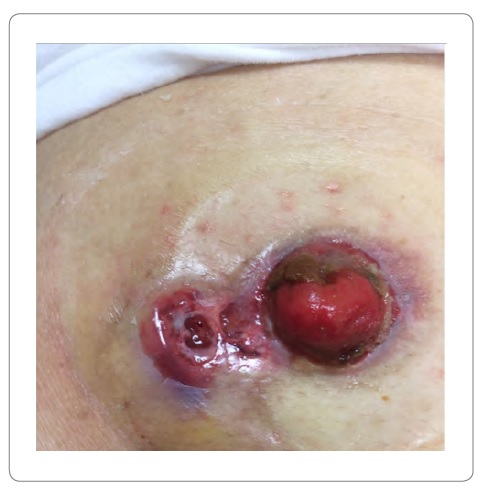Highlights
What medication may cause of painful refractory para-stomal ulceration of this loop ileostomy?
- Pravastatin
- Isosorbide mononitrate
- Nicorandil
- Linagliptin
Clinical Image Summary
87-year-old female presented with slow-healing ulcers and a colovaginal fistula. The patient’s past medical history included having multiple coronary stents and a failed coronary bypass in 2018 resulting in residual angina (Aspirin, Nicorandil, Furosemide, Isosorbide mononitrate), Type 2 Diabetes Mellitus (Insulin, Linagliptin and Metformin), Hypercholesteremia (Pravastatin), Hypertension (Sotalol), Chronic kidney kisease ktage 3b, and Atrial fibrillation (Apixaban).

Started on Nicorandil in November, 2017 the patient noted subtle changes in bowel habit which warranted a colonoscopy in September, 2018 revealing uncomplicated diverticulosis. In December, 2019 her bowels were opening eight times a day with an associated tender perineum and foul vaginal discharge; colonoscopy performed in January, 2020 found a colovaginal fistula 10 cm above the anal verge. A laparoscopic low anterior resection with loop ileostomy was performed February, 2020. In May, 2020 an area of suspected painful pyoderma at 7o’clock was noted. Post gastograffin rectal-enema in June, 2020 no anastomotic leak was detected and a reversal ileostomy with excision of pyoderma was performed July, 2020. Histopathology from the excised suspected pyoderma revealed the ulcer’s pathophysiological process being endarteritis obliterans.
Recovering well from the operation, in February, 2021 she was admitted for anginal chest pain with a normocytic anaemia from sudden onset rectal bleeding. An inpatient colonoscopy showed an ulcerated sinus at the level of the anastomosis discharging Hemopurulent fluid. An outpatient CT with rectal contrast in April, 2021 confirmed extravasation of rectal contrast into an antero-lateral cavity.
During a further admission in May, 2021 the Nicorandil was stopped, CT guided drainage and pigtail stent was inserted which grew Candida glabrata complex and Saccharomyces cerevisiae, and an OVESCO clip was applied to close the fistula. Post-operatively on day 7 rectal bleeding occurred and was treated with Argon plasma coagulation. The patient was discharged on day 14 to rehabilitation with no further bleeding.
Nicorandil, introduced in 1983 is utilised in severe ischaemic heart disease to alleviate angina via the dual of action of potassium channel opening and nitric oxide donation, increasing coronary blood flow, reducing preload and afterload [1]. In the literature it has been associated with oral ulceration since 1997, parastomal ulceration since 2007, and diverticular fistulation since 2010 with cessation being enough to halt the pathophysiological process [2–4]. The median time to onset of symptoms is around 2 years and is likely dose dependent [5]. The pathological process is contentious and the histopathology has not been well described in the literature; this is the first time the process has been described as endarteritis obliterans. It has been noted that on the withdrawal of nicorandil median time to resolution is 4, 3 weeks with no reports of healing with the continuation of treatment [6].
Acknowledgments
The authors would like to thank MJ for the final pictures provided to the Authors for the finished paper.
Contribution Statement
LJS conceived the idea of the project, designed, acquired consent, analyzed, and interpreted the patient information kindly provided by EO. LJS and EO contributed to the drafting and writing of the article. LJS and EO reviewed and approved the final version of the manuscript.
Data
Technical analysis can be accessed upon request from the author.
Patient and Public Involvement
Patients and/or the public were not involved in the design, or conduct, or reporting, or dissemination plans of this research.
Funding
This research received no specific grant from any funding agency in the public, commercial or not-for-profit sectors.
Conflicts of Interest
The authors claim no conflicts of interest.
Keywords
Nicorandil; Complication; Para-stomal; Ulcer; Endarteritis obliterans; Fistula
Cite this article
Sisk LJ, Moloney J, Evans J, Ong E. Parastomal ulceration—what else could it be? Clin Surg J. 2021;2(2):1–2.
Copyright
© 2021 Louis J Sisk. This is an open access article distributed under the terms of the Creative Commons Attribution 4.0 International License (CC BY-4.0).

